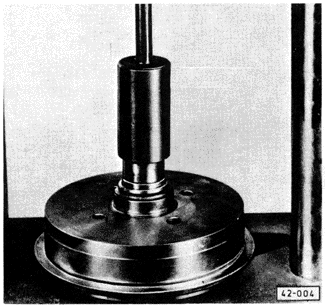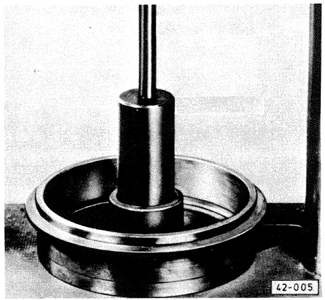Removing and Installing Rear Wheel Bearings
The rear wheel bearings can be removed, installed, and adjusted using ordinary hand tools. If the bearings are to be replaced, matching bearing outer races also should be replaced. The races are most easily and properly installed using a press.
Wheel bearing grease seals, if removed, should always be replaced. The axle nut hardware is locked in place with a cotter pin which should always be replaced rather than reused. To avoid contamination and early bearing failure, replace grease caps which are damaged in any way.
To remove:
| 1. | Raise the rear of the car, support it securely on jack stands which are designed for the purpose, and remove the wheel. |
| 2. | On cars with drum brakes, fully back off the brake adjuster (adjust the brake shoes away from the drum) as described in BRAKES. |
| 3. | On cars with rear disc brakes, remove the rear brake caliper, as described in BRAKES, and hang it out of the way without disconnecting the brake line, using a stiff wire or equivalent. |
| 4. | Carefully pry off the grease cap in the center of the brake drum or disc, remove the cotter pin and nut lock, and then remove the axle nut, the thrust washer, and the outer bearing. |
CAUTION-
If the rear wheel bearings are to be reused, Volkswagen advises against cleaning them with solvents. Carefully protect the parts from dirt and moisture while they are removed, then reinstall with additional fresh grease as required.
|
NOTE-
If the thrust washer and outer bearing are reluctant to move, thread the axle nut back on, leaving a slight gap between it and the thrust washer. A slight jerk on the brake drum, pulling away from the car, will loosen the bearing and thrust washer. The nut will prevent scattering the parts on the ground.
|
| 5. | Remove the brake drum or rotor. Pull it straight off the stub axle to prevent damage to the bearing races and the threads of the stub axle. |
| 6. | Working on the back side of the brake drum or rotor, pry the grease seal out of the recess in the hub. Lift out the inner bearing. |
| 7. | If the brake drum or rotor is being replaced, or if the bearings are being replaced, use a brass drift or punch to drive the outer bearing races out of the hub. A brass drift is used to avoid damaging the machined surfaces of the hub. |
To install:
| 1. | Inspect the bearing rollers and races. Replace any that is pitted, burred, rough, or heat-blued. |
CAUTION-
If the rear wheel bearings are to be reused, Volkswagen advises against cleaning them with solvents. Carefully protect the parts from dirt and moisture while they are removed, then reinstall with additional fresh grease as required.
|
| 2. | Install the outer bearing races in the hub, using a hydraulic press as shown in Fig. 6-4 and 6-5. |
| Fig. 6-4. | New outer wheel bearing outer race being pressed into hub. Brake drum shown installation in disc brake rotor is similar. |

|
| Fig. 6-5. | New inner wheel bearing outer race being pressed into hub. Brake drum shown. Installation in disc brake rotor is similar. |

|
| 3. | Pack the inner bearing with multipurpose grease. Coat the bearing outer races in the hub with grease, and lightly coat the interior of the hub to prevent corrosion. |
CAUTION-
Use only multipurpose (lithium) grease to lubricate the rear wheel bearings. Other greases will not maintain adequate lubrication and may lead to bearing failure.
|
NOTE-
When packing bearings, cup the grease in the palm of your hand and force it into the bearing all possible ways, especially around the rollers from the ends, until the bearing is completely filled with grease and it oozes out the other side. If in doubt, pack in some more.
|
| 4. | Place the inner bearing in its outer race on the back side of the hub, and press in a new grease seal. |
| 5. | Lightly coat the surface of the stub axle with grease, and slide the brake drum or rotor onto the stub axle. Move carefully to avoid damaging the grease seal or the bearing races on the threads of the stub axle. |
| 6. | Pack the outer bearing with multipurpose grease, and slide it over the stub axle and into its outer race. Install the thrust washer and the axle nut. Tighten the nut until the bearings just contact their outer races and the assembly just starts to become snug. |
| 8. | Fill the grease cap with approximately 10 grams (5/16 oz.) of multipurpose grease. Install the grease cap using a soft-faced mallet. |
| 9. | On cars with disc brakes, install the rear brake caliper as described in BRAKES. |
| 10. | On cars with drum brakes, adjust the brakes as described in BRAKES. |
| 11. | Install the wheel and tire. Torque the lug bolts to 110 Nm (81 ft. lb.). |
|

